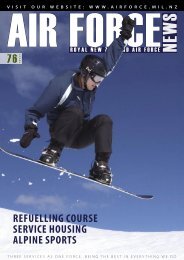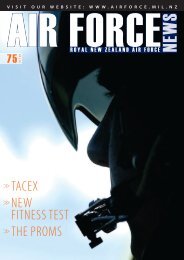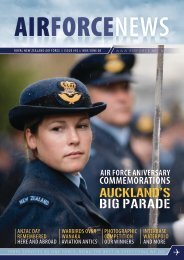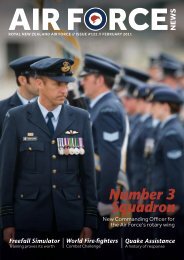June 2006, Issue 71 [pdf 2.8mb, 40 - Royal New Zealand Air Force
June 2006, Issue 71 [pdf 2.8mb, 40 - Royal New Zealand Air Force
June 2006, Issue 71 [pdf 2.8mb, 40 - Royal New Zealand Air Force
Create successful ePaper yourself
Turn your PDF publications into a flip-book with our unique Google optimized e-Paper software.
14<br />
TOP CLASS MEDICS<br />
Highly trained, multi-skilled and fully competent. Rest assured that<br />
while on deployment NZDF personnel are in the best of medical<br />
hands. The RNZAF’s ‘top class’ medics are trained to a very high<br />
professional standard and are fully competent to diagnose, treat and<br />
respond appropriately to most medical situations. Grant Carr talked to<br />
F/S Russell Clarke about the RNZAF Medical Trade.<br />
Despite rumours to the contrary the RNZAF Medical Trade – with 45<br />
personnel including 41 medics, two doctors and two administrators<br />
- is thriving, says Auckland-based medic F/S Russell Clarke. Its<br />
development of an extensive training programme for medics and expansion<br />
into setting up a Boeing 757 Aeromedical Evacuation are further proof that<br />
the trade is now fi rmly entrenched, he says.<br />
But there was a time, back in 2000, when the trade’s future was less<br />
secure. A Defence-wide review of medical services, the Defence Medical<br />
Review (DMR) was aimed at working out just precisely what were the<br />
user requirements for medical and dental services within the NZDF. The<br />
RNZAF decided to suspend recruiting medics until the DMR was complete.<br />
Unfortunately the uncertainty around the trade’s future saw many good<br />
medics leave for further education or more secure jobs in the ambulance<br />
and other medical services.<br />
A fi rm directive from then CAF AVM John Hamilton stopped the rot and<br />
recommitted the RNZAF to a medic trade within the Service. Recruiting<br />
new medics began in earnest in 2002. Up to six new medics are now<br />
being recruited annually bolstered by Service transfers from Army and<br />
Navy and some re-enlistments. The biggest problem facing the trade now<br />
is retaining senior medics so they can pass on their considerable skills to<br />
new recruits.<br />
The main advantages of having a Service-based Medical Trade, says<br />
F/S Clarke, are that ‘we can keep a close eye on the medical standards<br />
of our Service personnel. Time is not wasted on going to see a General<br />
Practitioner (doctor) and we can also monitor what medical conditions and<br />
medications RNZAF personnel have. It also benefi ts our personnel to have<br />
continuity of care when dealing with medical conditions or issues. We have<br />
very stringent follow-up procedures in place to make sure personnel get<br />
a high standard of follow-up medical care.<br />
‘It also means that when we deploy overseas and in the fi eld within <strong>New</strong><br />
<strong>Zealand</strong>, the squadrons know us as another <strong>Air</strong> <strong>Force</strong> personnel/medic<br />
and how we operate.’<br />
EXTENSIVE TRAINING<br />
The RNZAF medic’s training is both unique and extensive in that it covers<br />
many specialist medical occupations.<br />
Like doctors (although obviously to a lesser extent) our medics are taught<br />
to diagnose and treat and are taught basic nursing skills.<br />
‘Like paramedics we cover pre-hospital emergency care. We learn<br />
basic laboratory skills (drawing blood and taking swabs), like Laboratory<br />
Technicians. We also learn about Environment Health and Occupation<br />
Health and Safety as these are roles we pick up while deployed<br />
operationally overseas, says F/S Clarke.<br />
Medics must fi rst complete a Junior Medics Course (JMC). This is<br />
a fulltime course completed at Burnham Army Camp’s Joint Services<br />
Health School (JSHS). The three-month course covers such subjects as<br />
Responsibilities of the Medic/Medical Assistant, Basic Health Sciences,<br />
the Diagnostic Process, Administer Basic Emergency Care, Manage Minor<br />
Medical/Surgical Conditions, Perform Patient Care and Assessment<br />
Procedures, Pharmacology, Basic Preventative Medicine Measures and<br />
Medical Administration.<br />
Medics are then posted to an RNZAF Base Medical Flight where they<br />
spend the next <strong>40</strong> weeks working under supervision and are mentored<br />
by a senior medic. They have a task book and assignments as well as an<br />
Anatomy and Physiology exam they must pass before going on to complete<br />
their Intermediate Medics Course (IMC).<br />
The three-month IMC is also at Burnham’s JSHS and covers, in greater<br />
depth, the same subjects as the JMC.<br />
Medics then spend 10 weeks attached to a civilian hospital - currently<br />
Christchurch Public Hospital - where they work in the Emergency<br />
Department, Theatre, Post Op (caring for patients directly after surgery),<br />
General and Orthopaedic wards. They complete a task book including<br />
certain procedures and assessments during this training.<br />
After civilian hospital training medics go on to complete civilian<br />
ambulance training. Fulltime for fi ve weeks they are attached to a civilian<br />
ambulance service - currently with the St Johns Ambulance Service in<br />
Christchurch. They are mentored by an experienced Advanced Paramedic<br />
and get procedures and assessments signed off in their task book.<br />
Once all this training is completed the medics can operate under the<br />
Defence Medical Treatment Protocols (DMTPs) as qualifi ed medics. The<br />
DMTPs are issued by the Director General of Defence Medical Services<br />
(DGDMS) and allow medics to administer medications without the direct<br />
supervision of a doctor. Medics have to complete annual competencies to<br />
stay current to use the DMTPs, if they do not complete these competencies<br />
they cannot work unsupervised.<br />
Medics then go on to complete the Diploma in Military Medicine (DMM).<br />
This is civilian qualifi cation and is run by the Auckland University of<br />
Technology (AUT) and JSHS. It is made up of fi ve modules: Biological and<br />
Social Science (9 weeks in duration), Diagnosis and Treatment (8 weeks),<br />
Emergency Care and Disaster Medicine (6 weeks) and the Practice of<br />
Military Medicine (3 weeks). After the completion of the Emergency Care<br />
and Disaster Medicine module medics are reclassifi ed to Senior Medics and<br />
can deploy on sole charge (without a doctor) on exercises and operational<br />
deployments.<br />
After medics have completed their Diploma they are encouraged to go<br />
on and complete other tertiary medical education. ‘We currently have one<br />
medic who has completed their Bachelor in Health Science Paramedic<br />
(Advanced Paramedic qualification) and is currently completing an<br />
Aeromedical Retrieval and Transportation Diploma,’ says F/S Clarke.<br />
AFN<strong>71</strong> JUNE 06 www.airforce.mil.nz


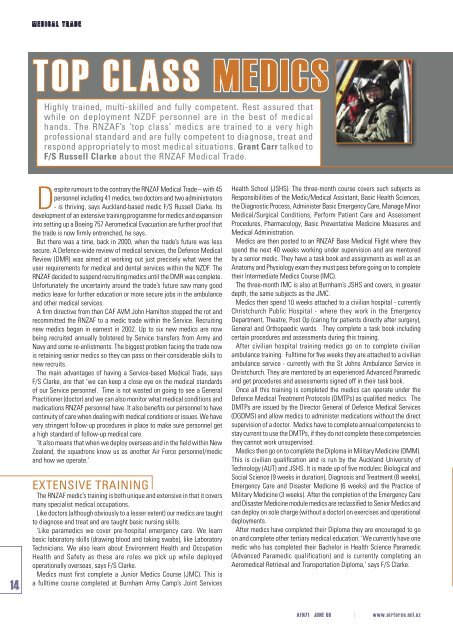
![February 2007, Issue 78 [pdf 3mb, 44 pages] - Royal New Zealand ...](https://img.yumpu.com/17485296/1/184x260/february-2007-issue-78-pdf-3mb-44-pages-royal-new-zealand-.jpg?quality=85)



